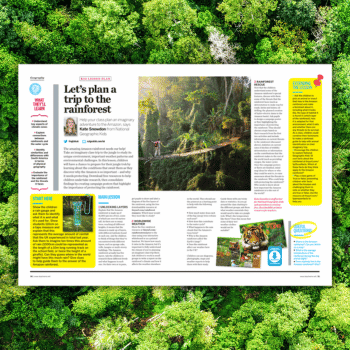PDF lesson plan and National Geographic fact sheets
KS2
Years 3-6
Use this rainforest KS2 geography lesson plan to take an imaginary class trip to the jungle. Pupils will study its unique environment, important weather patterns and environmental challenges.
In this lesson, written by Kate Snowdon from National Geographic Kids, children will have a chance to prepare for their jungle trek by learning about the conditions that await them. They’ll discover why the Amazon is so important – and why it needs protecting.
Use the accompanying fact sheets to help children undertake research, then consolidate findings by creating campaign posters that highlight the importance of protecting the rainforest.
Rainforest KS2 learning objectives
- Understand key aspects of climate zones
- Explore connections between rainforests and the water cycle
- Identify similarities and differences with South America in terms of physical geography
- Evaluate the importance of the rainforest and the threats it faces
Rainforest fact sheets
Use the included fact sheets to answer the following questions:
- How much water does each of the big canopy trees release each year?
- How does this contribute to the water cycle?
- What happens to the rain clouds that the Amazon’s trees form?
- Why is the Amazon rainforest called ‘the Earth’s lungs’?
- Does the rainforest affect our weather here in the UK?
Starter activity
Show the children a rain gauge. Ask them to identify what it is and what we use it for. Show students 110cm on a tape measure and explain that this represents the average amount of rainfall that the UK experienced in total last year.
Ask students to imagine ten times this amount of rain. You can represent 1000cm as the length of a 10m long running track on the school field, or twice the height of a giraffe.
Can they guess where in the world might have this much rain? Give clues to help guide them to the answer of the Amazon rainforest.
Kate Snowdon is staff writer for National Geographic Kids and specialises in creating free, downloadable primary resources for teachers. Browse more resources for World Environment Day.











